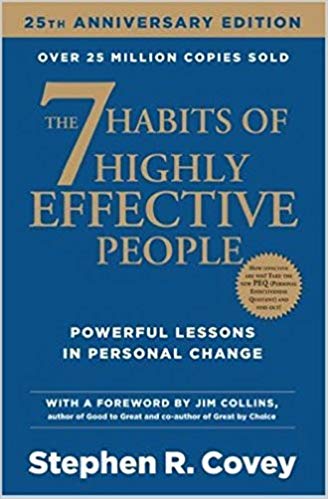

This article is an excerpt from the Shortform summary of "The 7 Habits of Highly Effective People" by Stephen Covey. Shortform has the world's best summaries of books you should be reading.
Like this article? Sign up for a free trial here .
Have you ever wondered how to change your character? What does it mean to change your character, and why should you consider it? What are methods you can use to make sure you change your character for the better?
The 7 Habits of Highly Effective People provides an inside-out approach on how to change your character, and improving yourself and your life. This method entails examining and adjusting your character, your motives, and how you see the world in order to change how you behave and how you interact with others. Keep reading to find out ways your character defines you, and steps you can take to change it.
Change Your Character from the Inside Out
The 7 Habits of Highly Effective People endorses an inside-out approach on how to change your character. This method starts with examining and adjusting your character, your motives, and how you see the world; only when you start from the foundation of your character and your worldview can you make lasting behavioral changes.
This inside-out approach entails
- Making improvements to your character before your personality
- Focusing on principles before practices
- Adjusting your paradigms, or how you see the world, in order to change your actions
- Improving yourself (achieving so-called “private victories”) before you can build better relationships with others (“public victories”)
Character is the Foundation for Personality and Behavior
There are two approaches to self-improvement: Character Ethic and Personality Ethic. It’s important to understand these approaches when you learn how to change your character.
Character Ethic focuses on foundational traits, including integrity, humility, hard work, loyalty, self-control, courage, justice, patience, modesty, and morality. These are basic principles that any person — in any culture or time period — could agree are important.
In the first 150 years or so of this country’s existence, most publications about how to be successful used a Character Ethic approach.
Personality Ethic emphasizes skills and practices that affect your public image, attitudes, and behaviors. This approach offers quick-fix solutions — how to be more charming, have a more positive outlook, make people like you, and influence people to do what you want. However, these solutions generally only work temporarily, while the underlying problem remains and ultimately resurfaces.
After World War I, success literature largely shifted focus from Character Ethic to Personality Ethic.
Character Ethic addresses primary traits, while Personality Ethic encompasses secondary traits, like communication skills, interpersonal strategies, and positive thinking. These techniques are often essential for success, but they are flimsy and ineffective if they’re not based in character that supports them; you must start with the foundation. For example, if you try to use communication skills to make people trust you, but your character is not honest and trustworthy, the effects will be hollow and eventually people will see through the act.
In one-time or short-term scenarios, you may be able to get by on personality alone. But without the foundation of primary traits — Character Ethic — the secondary traits will never have a lasting impact.
Working on personality improvements without first establishing the necessary character traits would be like a farmer trying to fit all her work into one season, and will not effectively teach you how to change your character. If the farmer skips planting in the spring and neglects to water and nurture the buds all summer, then tries to plant, water, and harvest in the fall, it won’t work. You can’t shortcut the process.
How to Change Your Character: An Ongoing Process
In the process of change, no step can be skipped — just as a child must learn to first crawl, then walk, then run. We tend to understand this more easily in a physical context, but it’s also true in emotional, interpersonal and personal growth.
The problem with self-improvement through the Personality Ethic alone is that it attempts to make a good impression but shortcuts real personal growth by skipping the change in character. Such shortcuts are not worth the trouble, because you waste time and effort on a result that has no substance and produces short-term results.
For example, if you’re a novice tennis player and try playing with pros, you may temporarily deceive others (and even yourself) into thinking you’re better than you are, but ultimately people will see through the ruse. The most effective way to make real change is to truthfully acknowledge your skill level and work to improve it incrementally.
Sometimes business executives attempt to shortcut progress with external changes — making mergers and acquisitions, implementing new workflows, mandating workshops — when the issue is in the company’s structure or culture.
Often, the way we frame a problem is the problem: If we are concerned with the symptoms instead of the underlying cause, this misdiagnosis contributes to (or, at best, does nothing to resolve) the real issue. This is the same way the Personality Ethic leads us to believe that a problem and its solution lie in the superficial realm.
- Example 1: You are a business executive or manager and try to treat your employees well, but you suspect they are not loyal and would slack off if you were out for the day. The problem may not be your employees, but your attitude about them. Do you truly have their best interest at heart? Or do you treat them as assets more than people, and perhaps they pick up on that and behave accordingly?
- Example 2: You are constantly moving and working but feel there are never enough hours in the day; you’ve tried to improve your time management and efficiency, but you still don’t feel you’re living a happy, balanced life. The problem may not be the amount of work you’re getting done or the time it takes you to do it, but rather a paradigm that’s affecting how you view your time, life, and priorities.
- Example 3: Your marriage feels like it’s lost its luster, and counseling and other efforts aren’t doing much to stoke the fire. Maybe the problem isn’t your spouse or your marriage. Maybe the problem is your views and expectations of love and a healthy marriage.
In relationships, you can shortcut real change and improvement by “borrowing strength” to force a superficial change; you may do this by flexing your authority, knowledge, experience, or physical size and strength. Borrowing strength to force change actually breeds weakness in multiple ways.
- First, it weakens the power of the borrower by making her dependent on these external symbols of supposed strength.
- Second, it weakens the other person by robbing him of the opportunity to have a genuine exchange and come to a mutually agreeable result.
- Third, it weakens the relationship by using fear and coercion in place of cooperation.
Covey tells a story of when he borrowed strength by forcing his three-year old daughter to share her new toys with friends at her birthday party. He first asked her to share, then tried reasoning with her, then bribed her with a treat, and finally threatened her with punishment; she refused each time. Feeling embarrassed at his daughter’s behavior as the other children’s parents watched, Covey forcibly grabbed the toys and handed them to the other children.
Covey had borrowed strength from his size and authority to force his daughter to share her toys. He understood in retrospect that, at her age and maturity level, she needed the emotional space to feel she had true possession and ownership of the toys before she could willingly share them. It would have been more valuable to their relationship if he had considered that insight and diverted the other children’s attention to other toys and games to give his daughter the emotional space she needed.
How to Change Your Character: Advice from 2 of the 7 Habits
Since changing your character is quite an undertaking, this is a quick look at how 2 of the habits help you learn how to change your character with their synergistic approach. Keep in mind that all 7 habits help you learn how to change your character. These habits are just a glimpse at the work you’ll do when figuring out how to change your character.
Habit 2: Begin with the End in Mind
To achieve the life you want, you must start with the end in mind. This means identifying the big picture — the life you want to lead, the character traits you want to embody, the impact you want to have on those around you — and then ensuring each daily action is in line with your ultimate goals.
Think of driving to an appointment: How can you know which streets to take and turns to make if you don’t know where your destination is? Without a destination in mind, you might still make it there eventually, but it’ll be a long and roundabout route to get there. Effectiveness is following a direct route to get to your destination.
Another important part of your character is creating a personal mission statement. This will help you stay focused on who you are, who you want to be, and your goals.
A personal mission statement focuses on three main things:
- Character: Who do you want to be?
- Contribution: What do you want to do?
- Achievements: What are the core values and principles that govern your character and contributions?
Habit 4: Develop a Win/Win Paradigm
Character is the bedrock of a Win/Win paradigm, encompassing three critical traits.
1. Integrity — your commitment to “walk the talk” and live out your values and principles — is essential to a Win/Win mindset. If you don’t know what your values are, then you can’t determine what constitutes a win for you in the first place. Additionally, if you can’t keep the commitment to yourself to remain true to your principles, then how can other people believe that you’ll genuinely commit to helping them win?
2. Maturity requires you to balance the courage to express your goals and expectations with the consideration to factor in the other person’s perspective. Courage allows you to pursue the P (what you want) while also maintaining the PC (the relationship).
Think of a diagram with four quadrants, measuring courage on one axis and consideration on the other.
- Low courage and low consideration create a Lose/Lose paradigm
- Low courage and high consideration create a Lose/Win paradigm
- High courage and low consideration create a Win/Lose paradigm
- High courage and high consideration create a Win/Win paradigm
3. An Abundance Mentality reassures you that there is plenty — of success, money, and happiness — for everyone. You can only see the possibility of both people winning if you believe that one person’s success doesn’t come at the expense of the other person’s success. The Abundance Mentality requires a deep conviction of self-worth and security; once you know that you possess a unique inner value and a personal sense of direction, you can appreciate and celebrate others’ value and direction.
Learning how to change your character is not easy, and is an ongoing process that requires a lot of self-reflection, effort, and support. In discovering how to change your character, you can also discover a lot about yourself, and who you want to be.
———End of Preview———

Like what you just read? Read the rest of the world's best summary of "The 7 Habits of Highly Effective People" at Shortform . Learn the book's critical concepts in 20 minutes or less .
Here's what you'll find in our full The 7 Habits of Highly Effective People summary :
- How to prioritize the hundred tasks you have to focus on the one or two that really matter
- The right way to resolve every disagreement and argument
- How to avoid burning out and succeed over 20+ years






